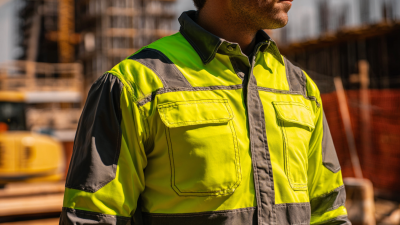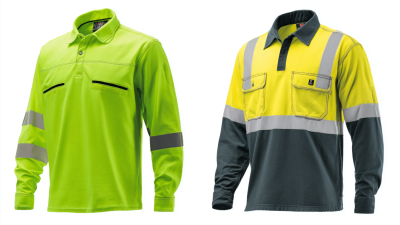In today's diverse workforce, the importance of visibility in hazardous environments cannot be overstated. Hi Vis Shirts play a critical role in ensuring safety for workers across various industries, from construction and road maintenance to warehousing and event management. According to the Occupational Safety and Health Administration (OSHA), high-visibility clothing is essential for reducing the risk of accidents and injuries, as it significantly enhances a worker's visibility in low-light conditions and cluttered environments. A recent industry report from the National Safety Council indicates that incorporating proper Hi Vis Shirts can reduce workplace injuries by up to 30%. Given the array of options available, understanding how to choose the best Hi Vis Shirts tailored to specific job requirements is vital for maintaining safety standards and ensuring the well-being of employees.

When selecting hi vis shirts for workplace safety, it is crucial to understand the various standards that govern visibility in different job environments. Hi vis clothing is classified according to the ANSI/ISEA 107 standard, which categorizes garments based on their visibility and the conditions under which they will be used. For instance, Type O (Off-Road) garments are designed for non-public roadway applications, while Type R (Roadway) shirts are suitable for workers exposed to highway traffic. Understanding these classifications helps ensure that employees are wearing the appropriate attire for their specific job requirements.
In addition to meeting standards, the choice of material and design plays a significant role in effectiveness. Hi vis shirts made from lightweight, moisture-wicking fabrics not only enhance comfort but also increase wearability in high-heat environments. Features such as reflective strips and pockets can further improve visibility and functionality, making it essential to select shirts that align not just with safety standards but also with the practical needs of workers. By prioritizing both compliance and comfort, employers can create a safer work environment while ensuring that their employees remain visible and protected.
This chart represents the different categories of Hi Vis shirts commonly used across various industries and their respective safety standards compliance percentage.
When selecting a high visibility (hi vis) shirt, the choice of material is crucial for ensuring both comfort and durability in the workplace. Typically, hi vis shirts are available in a variety of fabrics, including cotton, polyester, and blends. Cotton is known for its breathability and comfort, making it an excellent option for warmer conditions; however, it may not offer the same level of durability or moisture-wicking properties as synthetic materials. On the other hand, polyester is more robust and resistant to wear, which ensures that the shirt maintains its visibility and structural integrity over time.
In addition to the primary material, considering the weight and weave of the fabric can enhance performance. Lighter materials can improve comfort in heat but may compromise durability, while heavier fabrics provide greater protection against wear and tear. Furthermore, moisture-wicking features are essential for keeping the wearer dry and comfortable, especially in demanding jobs. Ultimately, understanding the specific requirements of the job and the environment will guide the choice of the most suitable hi vis shirt material, balancing the need for comfort, safety, and longevity.

When selecting high visibility (Hi Vis) shirts for various job roles, it's important to consider the specific needs and requirements that each position entails. For instance, construction workers often require shirts with additional durability and breathability due to their physically demanding environment. The latest trends in workwear design, inspired by industries such as Formula 1, emphasize not just functionality but also style, ensuring that workers are both safe and comfortable while portraying a professional image.
In retail settings, Hi Vis shirts might focus more on design elements that enhance branding while maintaining visibility. Sales associates and store managers benefit from shirts that provide a unified look, promoting team cohesion, while still being appropriate for face-to-face customer interactions. As the job roles diversify, from logistics coordinators to specialized positions, recognizing the key attributes of Hi Vis shirts—such as fabric technology and ergonomic fit—becomes crucial in catering to the diverse needs of the workforce.
When choosing hi vis shirts, particularly for women in the workplace, evaluating the fit and function is crucial for enhanced mobility and safety. A well-fitted hi vis shirt can significantly reduce risks associated with poorly designed personal protective equipment (PPE). According to industry reports, approximately 30% of female workers in safety-intensive roles report that standard fitting PPE does not accommodate their body types, which can lead to discomfort and increased vulnerability on the job site.
New designs focusing on ergonomic fit and flexibility are transforming how women's workwear is conceptualized. By incorporating features such as adjustable elements and materials that allow for greater range of motion, manufacturers are addressing the unique risks women face in various industries. Studies have shown that gear that aligns better with the wearer's body leads to higher compliance with safety protocols and improved overall performance in hazardous environments. Investing in properly fitted hi vis shirts is not just a matter of comfort; it is essential for enhancing the effectiveness of safety measures within the workplace.
Maintaining and caring for high visibility (hi vis) shirts is crucial to ensure their longevity and effectiveness. To keep your hi vis shirts in optimal condition, it’s essential to follow specific washing instructions. Always check the label for guidance on water temperature and detergent types. Most hi vis fabrics should be washed in cold water to prevent color fading and fabric degradation. Avoid using bleach, as it can damage reflective materials.
Tips for maintaining your hi vis shirts include regularly inspecting them for any signs of wear and tear. Addressing small issues like loose seams or frayed edges promptly can prevent further damage. Additionally, look for any stains that could reduce the visibility of the shirt; treating these stains as soon as possible will help maintain their bright colors and reflective qualities. Finally, storing your hi vis shirts properly—folding them neatly and avoiding overcrowding—can help prevent wrinkles and prolong their lifespan.







